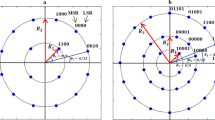Abstract
This paper presents a new learning-based framework to jointly solve equalization and symbol detection problems in orthogonal frequency division multiplexing systems with quadrature amplitude modulation. The framework utilizes extreme learning machine (ELM), a recent addition to the class of supervised learning algorithms, to achieve fast training, high performance, and low error rates. The proposed ELM scheme employs infinitely differentiable nonlinear activation functions in least-square solution to learn the channel response, which is the equalization part. In addition to equalization, ELM performs symbol detection. Existing learning-based schemes require an additional symbol slicer for the symbol detection. The proposed framework does not experience training bottleneck imposed by gradient descent–based approaches. Simulation results show that the proposed framework outperforms other learning-based equalizers in terms of symbol error rate and training speeds.










Similar content being viewed by others
References
Zhao Y, Haggman S (2001) Intercarrier interference self cancelation scheme for OFDM mobile communication systems. IEEE Trans Commun 49:1185–1191
Piazzo L, Mandarini P (2002) Analysis of phase noise effects in OFDM modems. IEEE Trans Commun 50:1696–1705
Shentu J, Panta K, Armstrong J (2003) Effects of phase noise on performance of OFDM systems using an ICI cancelation scheme. IEEE Trans Broadcasting 49:221–224
Fazel K, Kaiser S (2003) Multi-carrier and spread spectrum systems. Wiley, England
Bahai ARS, Saltzberg BR, Ergen M (2004) Multi carrier digital communications: theory and applications of OFDM. Springer, New York
Panayirci E, Senil H, Poor HV (2010) Joint channel estimation, equalization, and data detection for OFDM systems in the presence of very high mobility. IEEE Trans Signal Process 58:4225–4238
Muck M, de Courville M, Duhamel P (2006) A pseudorandom postfix OFDM modulator-semi-blind channel estimation and equalization. IEEE Trans Signal Process 54:1005–1017
Wu C, Shiue M, Wang C (2010) Joint carrier synchronization and equalization algorithm for packet-based OFDM systems over the multipath fading channel. IEEE Trans Vehicular Technol 59:248–260
Barhumi I, Leus G, Moonen M (2006) Equalization for OFDM over doubly selective channels. IEEE Trans Signal Process 54:1445–1458
Cui T, Tellambura C (2006) Joint data detection and channel estimation for OFDM systems. IEEE Trans Commun 54:670–679
Wu H, Huang X, Wu Y, Wang X (2008) Theoretical studies and efficient algorithm of semi-blind ICI equalization for OFDM. IEEE Trans Wireless Commun 7:3791–3798
Gao F, Nallanathan A (2007) Blind channel estimation for OFDM systems via a generalized precoding. IEEE Trans Vehicular Technol 56:1155–1164
Doukopoulos XG, Moustakides GV (2006) Blind adaptive channel estimation in OFDM systems. IEEE Trans Wireless Commun 5:1716–1725
Rugini L, Banelli P, Leus G (2005) Simple equalization of time-varying channels for OFDM. IEEE Commun Lett 9:619–621
Proakis JG (1989) Digital communication, 2nd edn. McGraw-Hill, New York
Haykin S (1998) Digital communication. Wiley, New York
Kechriotis G, Zervas E, Manolakos ES (1994) Using recurrent neural networks for adaptive communication channel equalization. IEEE Trans Neural Netw 5:267–277
Kim T, Adali T (2003) Approximation by fully complex multilayer perceptrons. Neural Comput 15:1641–1666
Kim T, Adali T (2001) Complex backpropagation neural network using elementary transcendental activation functions. In: Proceedings of IEEE international conference on acoustics, speech, signal process (ICASSP), Salt Lake City, pp 1281–1284
Jianping D, Sundararajan N, Saratchandran P (2002) Communication channel equalization using complex-valued minimal radial basis function neural networks. IEEE Trans Neural Netw 13:687–696
Cha I, Kassam SA (1995) Channel equalization using adaptive complex radial basis function networks. IEEE J Sel Area Commun 13:122–131
Li M, Huang G, Saratchandran P, Sundararajan N (2005) Fully complex extreme learning machine. Neurocomputing 68:306–314
Moustafa M, El-Ramly S (2009) Channel estimation and equalization using backpropagation neural networks in OFDM systems. In: Proceedings of IFIP international conference on wireless and optical communcation networks, Cairo, Egypt, pp 1–4
Lerkvaranyu S, Dejhan K, Miyanaga Y (2004) M-QAM demodulation in an OFDM system with RBF neural network. In: Proceedings of 47th midwest symposium on circuits and systems (MWSCAS), Hiroshima, Japan, pp II-581-II-584
Raivio K, Henriksson J, Simula O (1998) Neural detection of QAM signal with strongly nonlinear receiver. Neurocomputing 21:159–171
Huang GB, Zhu QY, Siew CK (2005) Extreme learning machine: theory and applications. Neurocomputing 70:489–501
Huang GB, Wang DH, Yuan L (2011) Extreme learning machines: a survey. Int J Mach Learn Cyber 2:107–122
Wang X, Lu J, Lin H, Zhang N, Sekiya H, Yahagi T (2002) Combining RNN Equalizer with SOM Detector. In: Proceedings of 6th international conference on signal processing (ICSP02), pp 1291–1294
Harada H, Prasad R (2002) Simulation and software radio for mobile communication. Artech House, Boston
Mitchell T (1997) Machine learning. McGraw-Hill, USA
Friedman JH (2002) Stochastic gradient boosting. Comput Stat Data Anal 38:367–378
Zhao G, Shen Z, Miao C, Man Z (2009) On improving the conditioning of extreme learning machine: a linear case. In: Proceedings of the 7th international conference on Information, communcation, and signal processing (ICICS2009), Macau, pp 1–5
Acknowledgments
Authors would like to thank Dr. Q.M. Jonathan Wu and Dr. Rashid Minhas for their valuable discussions and help to improve the quality of this manuscript.
Author information
Authors and Affiliations
Corresponding author
Rights and permissions
About this article
Cite this article
Muhammad, I.G., Tepe, K.E. & Abdel-Raheem, E. QAM equalization and symbol detection in OFDM systems using extreme learning machine. Neural Comput & Applic 22, 491–500 (2013). https://doi.org/10.1007/s00521-011-0796-y
Received:
Accepted:
Published:
Issue Date:
DOI: https://doi.org/10.1007/s00521-011-0796-y




